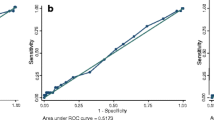Abstract
This paper introduces the clinical use of coagglutination as a method for the rapid detection of pneumococcal antigens in patients with community-acquired pneumonia and compares it with the sputum Gram stain and culture methods. Among 105 patients, 50 (48%) were diagnosed as having pneumococcal pneumonia by at least one of the three methods. Of 95 sputa tested, 44 (46%) were found to be positive by the coaggulation test, 26 (27%) by Gram staining and only 16 (17%) by the bacterial culture method. The rate of detection of pneumococcal antigens was thus greater with coaggulation than with either of the other two methods. The differences were very significant (bothP<0.01). Our study indicates that the advantages of coagglutination over the traditional bacteriological methods are its speed, sensitivity, convenience and also its relative independence of antibiotic therapy. It thus provides a new dimension in the aetiological diagnosis of pneumococcal pneumonia.
Similar content being viewed by others
References
Burdash NM (1982) Identification ofStreptococcus pneumoniae by the Phadebact coagglutination test. J Clin Microbiol 15:391–394
Edwards EA (1980) Coagglutination and counterimmunoelectrophoresis for detection of pneumococcal antigens in the sputum of pneumonia patients. J Clin Microbiol 11:488–491
Edwards EA (1980) Rapid detection of pneumococcal antigens in sputum and blood serum using a coagglutination test. Milit Med 145:256–258
Guzzetta P (1983) Rapid diagnosis of community-acquired bacterial pneumonia. Am Rev Respir Dis 128:461–464
Kalin M (1983) Diagnosis of pneumococcal pneumonia: a comparison between microscopic examination of expectorate, antigen detection and cultural procedures. Scand J Infect Dis 15:247–255
Kronvall G (1973) A rapid slide-agglutination method for typing pneumococci by means of specific antibody absorbed to protein A-containing Staphylococci. J Med Microbiol 6:187–190
Macfarlane JT (1982) Hospital study of adult community-acquired pneumonia. Lancet 2:255–258
Mayer ME (1983) Coagglutination for detection and serotyping of bacterial antigens: usefulness in acute pneumonias. Diagn Microbiol Infect Dis 1:277–285
Rein MF (1978) Accuracy of Gram's stain in identifying pneumococci in sputum. JAMA 239:2671–2673
Telenti A (1984) Persistence of pneumococcal antigens in sputum after treatment of pneumonia. Scand J Infect Dis 16:323–324
Whitby M (1985) Assessment of rapid methods of pneumococcal antigen detection in routine sputum bacteriology. J Clin Pathol 38:341–344
Author information
Authors and Affiliations
Rights and permissions
About this article
Cite this article
Zhang, X., Deng, K., Ye, Y. et al. Rapid detection of pneumococcal antigens in sputa in patients with community-acquired pneumonia by coagglutination. Med Microbiol Immunol 177, 333–338 (1988). https://doi.org/10.1007/BF02389905
Received:
Issue Date:
DOI: https://doi.org/10.1007/BF02389905




